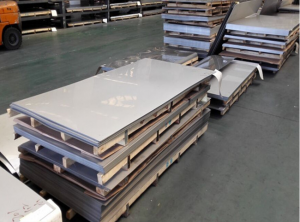
 Monel400 alloy is a versatile material that can be applied in many industrial fields: Seamless water pipes, steam pipes in power plant Sea water exchangers and evaporators Sulfuric and hydrochloric acid environments crude oil distillation Pump shafts and propellers for equipment used in sea water Used by the nuclear industry to manufacture equipment for uranium refining and isotope separation Manufacture of pumps and valves for hydrochloric acid production equipment
Monel400 alloy is a versatile material that can be applied in many industrial fields: Seamless water pipes, steam pipes in power plant Sea water exchangers and evaporators Sulfuric and hydrochloric acid environments crude oil distillation Pump shafts and propellers for equipment used in sea water Used by the nuclear industry to manufacture equipment for uranium refining and isotope separation Manufacture of pumps and valves for hydrochloric acid production equipment MONEL K-500 alloy has the same corrosion resistance as 400, but has higher mechanical strength and hardness. It has good thermal corrosion resistance and long-term organizational stability. Ni≥63, Cu27-33, Al2.3-3.15, Ti0.35-0.85, Fe≤2.0, Mn≤1.5, Si≤0.5, C≤0.25, S≤0.01Density 8.80g/cm3 Modulus of elasticity 26 000 ksi Resistivity 5.11e-005 ohm-cm Melting point 1300 - 1350 °C Magnetic 200H(At 70 F) Mechanical Properties of K-500 Alloy Tensile strength: 70-90MPa Yield strength (0.2% Offset): 482-621KSI Elongation, %: 25-60Mpa Hardness: 172-413BrinellIt is mainly used to manufacture turbine blades and gas turbine blades on aero-engines whose working temperature is below 750°C; to manufacture fasteners and springs on ships; pumps and valve parts on chemical equipment; scraper blades on paper-making equipment Wait. 1. Valve seals, pump sleeves, wear rings in marine environments (high strength and seawater corrosion resistance). 2. Fasteners such as bolts are used in marine atmosphere and tidal water, and are resistant to corrosion in environments containing chloride ions. 3. Medical blades and scrapers.
MONEL K-500 alloy has the same corrosion resistance as 400, but has higher mechanical strength and hardness. It has good thermal corrosion resistance and long-term organizational stability. Ni≥63, Cu27-33, Al2.3-3.15, Ti0.35-0.85, Fe≤2.0, Mn≤1.5, Si≤0.5, C≤0.25, S≤0.01Density 8.80g/cm3 Modulus of elasticity 26 000 ksi Resistivity 5.11e-005 ohm-cm Melting point 1300 - 1350 °C Magnetic 200H(At 70 F) Mechanical Properties of K-500 Alloy Tensile strength: 70-90MPa Yield strength (0.2% Offset): 482-621KSI Elongation, %: 25-60Mpa Hardness: 172-413BrinellIt is mainly used to manufacture turbine blades and gas turbine blades on aero-engines whose working temperature is below 750°C; to manufacture fasteners and springs on ships; pumps and valve parts on chemical equipment; scraper blades on paper-making equipment Wait. 1. Valve seals, pump sleeves, wear rings in marine environments (high strength and seawater corrosion resistance). 2. Fasteners such as bolts are used in marine atmosphere and tidal water, and are resistant to corrosion in environments containing chloride ions. 3. Medical blades and scrapers. 4. Lanyard metal shell --- high strength, non-magnetic and seawater corrosion resistance; 5. Oil well drilling equipment such as non-magnetic drill bits, valve bodies and instrument sleeves---resistance to corrosion in chloride ion-containing media and acid gas environments; 6. Spring --- resistant to a variety of corrosive media; 7. Non-magnetic aviation instrument parts.Monel K500 has corrosion resistance in a variety of media, resistance to chloride ion stress corrosion cracking, high strength and hardness. In the aging state, the mechanical properties of Monel 400 are about 2~3 times stronger than that of Monel 400. It still has high tensile strength at up to 650°C, good fatigue corrosion resistance, low magnetic permeability, and can reach -135 at low temperature. It is still non-magnetic at ℃.Thermal processing The annealing temperature should be controlled at 700-900 ℃, and rapid air cooling is recommended to obtain corrosion resistance. Time and temperature will directly affect grain size, and annealing parameters must be carefully formulated. cold working Intermediate annealing should be carried out for cold working. Has a high work hardening rate The cold forming deformation is higher than 5%, and it must be used after stress relief or annealing
4. Lanyard metal shell --- high strength, non-magnetic and seawater corrosion resistance; 5. Oil well drilling equipment such as non-magnetic drill bits, valve bodies and instrument sleeves---resistance to corrosion in chloride ion-containing media and acid gas environments; 6. Spring --- resistant to a variety of corrosive media; 7. Non-magnetic aviation instrument parts.Monel K500 has corrosion resistance in a variety of media, resistance to chloride ion stress corrosion cracking, high strength and hardness. In the aging state, the mechanical properties of Monel 400 are about 2~3 times stronger than that of Monel 400. It still has high tensile strength at up to 650°C, good fatigue corrosion resistance, low magnetic permeability, and can reach -135 at low temperature. It is still non-magnetic at ℃.Thermal processing The annealing temperature should be controlled at 700-900 ℃, and rapid air cooling is recommended to obtain corrosion resistance. Time and temperature will directly affect grain size, and annealing parameters must be carefully formulated. cold working Intermediate annealing should be carried out for cold working. Has a high work hardening rate The cold forming deformation is higher than 5%, and it must be used after stress relief or annealing